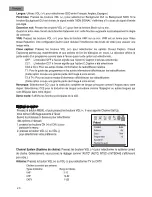
19
construction without cutting into the wall. They also eliminate much of the risk involved in working near
electrical and plumbing systems. Here is a list of tools needed for speaker mounting:
? Stud finder
? Tape measure
? Level
? Drywall Saw
? Pencil
? Power drill
? Flashlight
? Speaker template
—
usually comes with recessed speakers
? Wall probe
—
piano wire, etc
? Wire running tools
—
fish/carpet tape, flex rods, electrical
tape
Running Wires You'll have to get a wire from your speaker to your equipment. There are a few rules
you'll need to be aware of when it comes to running wires: The National Electrical Code (NEC) is a set
of rules that govern how wires and varying types of power are to be run in a building. These rules cover
both high voltage (outlets, light switches) and low voltage (phone lines, speaker wires, cable lines). Any
work you do MUST be in accordance with the NEC, as well as local ordnances for your city, county and
state. It's good to have a clear understanding of these rules before you begin. Speaker wire can be
susceptible to interference from external sources, such as electrical lines. The NEC dictates minimum
safe clearances for wires, but it is best to keep as much distance between your speaker wires and any
potential sources of interference
—
you don't want to get all the way through your install only to
discover your speakers "buzz" or "hum" constantly. The wire you use is as important as the speaker
and amplifier themselves. The type of copper and how thick it is, the jacket protecting the copper, the
distance it's run
—
all of these impact how your system will perform. Make sure you're choosing wire
that is the proper material and has a thick enough gauge for the location and distance it will be
run.There are also different wire ratings that dictate what kind of wires are run within different areas of a
house. For example, certain wires are "in-wall" rated, while others are rated for what can be run outside,
underground, in HVAC ducts, etc. Since this is spelled out by the NEC and in any local restrictions
codes, it is strongly recommended that you make use of a professional installer if you're unsure of local
ordinances.
Wire Running Technique
Carpet fish
—
This technique uses a specially designed flat wire to run between the carpet
and the pad. This should usually be routed through low-traffic areas to avoid wear on the wire.
Start by pulling up a section of carpet, usually near where your wire will be run to or from. Feed
carpet tape or another suitably long device from the start to the finish of your run, and tape the
wire securely.
TECHTIP:
When taping wire, make sure to "taper" the wire in a wedge or cone shape
—
any corners or edges on your tape job can catch and hamper your efforts. This works
best with two people
—
one to feed the wire, and one to pull from the other end.
Wall fish
—
This technique uses access from a basement or attic to run wires up or down a wall.
Interior walls are usually empty, but exterior walls will often be blocked with insulation.
TECHTIP:
If you have access to a wall where you need a wire fished, drill up from the
lower level or down from an upper level into the center of the wall. Once you have an
access hole drilled, run your wire fish tool, such as a flex rod, down to where you need the wire
run. Tape your wire and feed it through the wall to your desired location.
















































